HurricaneVision
Staff Writer
- Joined
- Nov 16, 2012
- Messages
- 943
I decided to review four of MSU’s games to see every play on defense to identify what Diaz likes to do, and to identify exactly how aggressive his blitz schemes are. Here are the games I looked at:
• Southern Miss- I looked at this game as it was on the road against a little brother who wanted to beat them more than anything, and it was the first game
• Auburn- Complete spread team with a power run game and a coach I think has clever schemes.
• Arkansas- A traditional offense with an excellent college QB.
• NC State- Bowl game, more prep time, good offense.
I charted every play and came away with some observations:
• In 304 plays, they rushed 4 on 161 of those plays (53.0% of the time)
• They rushed 3 on only 17 plays, with 15 of those coming on 3rd and long (5.6%)
• They rushed 5 on 79 plays, but against Arkansas, the traditional offense of the opponent group, they rushed 5 on 26 plays, and rushed 4 on 27 plays (virtually identical). Against spread teams they almost exclusively rushed 4.
• Diaz sent 6 rushers on 47 plays, only 15.5% of the time. I excluded the goal line plays, where defenses rush 6 or 7 on almost every play and they skew the numbers because a successful play is going to net you 2-5 yards.
Diaz’ defense basically wants to pressure you at all costs with their front-7, then they try to protect dep. Think of the field like a big circle, where the circle extends 10 yards past the LOS, 10 yards from the sidelines, and then 10 yards in front of the Safeties. The hole in this defense is within that area where the circle outline ends (the “hole” in the circle if you will). I purposely tried to avoid too many metrics on his defense to see if what I evaluated showed up in the statistics, and sure enough, MSU was highly rated in the tackles for loss, fared well in preventing big plays, and was below average in getting 3 and outs, and ending drives quickly. If a QB has an elite TE and a good OL, they will shred this defense. One poster on here went a little overboard with his criticism of the pass defense, but this defense is easier to pass against than it is to run against.
When it comes to 3rd down defense, you will see they did a very good job with stopping teams on 3rd down, 24-69 for 34.8% on 3rd downs. What this doesn't tell you though is teams went 0-9 on 3rd down when they rushed 3 defenders and dropped 8 into coverage. There is some bias built in here due to the fact they rushed 3 on the 3rd and longs only, so you'd expect them to stop them more often. It's a positive they rarely gave up 3rd and longs when going conservative. On the flip side, when the defensive went ultra-aggressive and rushed 6, the offense converted 8 of 15 opportunities (53%). When rushing 5, the offense converted 9 of 21 opportunities (43%), and when rushing 4 the opponent converted 7 of 24 chances (29%).
What this information doesn't tell you though is how often the opponent got the first down before needing to reach 3rd down. They had 101 2nd downs and only 69 third downs, meaning the offense converted a 1st down prior to 3rd down on 32% of their opportunities (a relatively high number).
Most of the big plays I saw the defense give up were the result of play action and a defensive back peeking into the backfield, or a trick play where the defense overpursued. That is something we will need to get used to- there will be plays where the defense gives up a big play out of overaggression. Some of the other big plays I noticed were simply the coach put them in position, but a player tried to do too much and allowed the offense to make a play.
I really liked the fact that Diaz aligns his words with his actions. He does, in fact, allow his players to play fast. What I believe will happen as we go along, is the speed of his defensive players here will close that circle I spoke of earlier from 10 yards from the LOS to 12 yards, and the end of the circle will change from 10 yards in front of the S to 12 yards in front. This sounds like a small difference, but think of the difference two yards makes in coverage ability. You’ve effectively shrunk the middle of the circle from a 40 yard area (10 x 4 zones) down to a 24 yard area to attack (6 x 4 zones). That’s a massive difference and would take a defense from really good to elite. Most college QB’s simply won’t be able to attack this area.
Weaknesses I found are that if the front-7 doesn’t get to the QB he will have a field day. They sacked Brandon Allen zero times in the Arkansas game and he shredded them. QB’s who can run and move around will really hurt this defense. In the NC State game, the QB did by far the most damage against them by running the ball or moving and passing the ball downfield. Elite TE’s will shred this defense in the middle of the field if the QB can get him the ball.
This defense will get back to hitting the opponent again and I am excited about that. The defense hit the QB on 30% of their dropbacks in these four games (44 out of 148 dropbacks).
Here are some observations with some screen shots from the four games, with the most focus on the Arkansas game as it intrigued me the most.
In this play against Southern Miss, the offense ran a jet sweep motion, the QB leaked to the other side of the field and the WR lateraled to the QB. The QB threw deep and here is how the defense was in position to stop this play.

The CB stops his feet because you see that all the time when the ball is in the air that long. Keep running young fella! Instead, he stop running, squares up and tries to jump to intercept the ball. The S is caught watching the man instead of playing the ball.
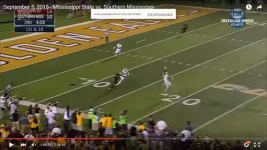
The result, as I'm sure you guessed, is that the ball is completed down to the 4-yard line. Maybe I'm being too easy on them, but this huge 50-yard play is something I kind of pass to because the coach put them in position, but the players just didn't make the easy play.
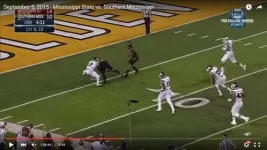
This is another play against Southern Miss that annoyed me. A simple draw play, the defense is in great position to stop it for a simple four yard gain, but they allow a huge play instead.
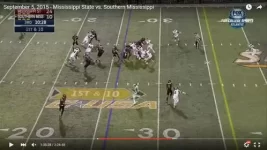
In the screen shot above, you have an unblocked slot corner not paying attention to the runner, an ILB scraping down the line to meet him in the hole, and a boundary corner at the second level trailing the WR if he does somehow get past those two. Here's the next frame:
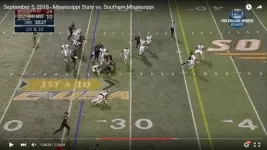
The ILB misses the tackle, the nickle CB slips to the ground, the boundary CB isn't looking at the ball and then even sets a beautiful screen preventing his S from getting over to tackle the ballcarrier. He ends up running for 44 yards down the sideline. Now, you decide for yourself if this is the defense getting shredded, or the defense being in a position to make the plays and a bunch of guys simply failing to make the easy play and stop this play.
There is another play with 10 guys within 10 yards of the LOS. I don't think I saw more than a handful of plays under our previous regime with more than 8 guys within 10 yards of the LOS. This makes me smile.
Switching to the Arkansas game, Diaz likes the two down linemen setup and walks up blitzers from all angles:
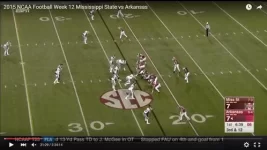
He does this so the defense isn’t sure where the blitzers are coming from. In virtually all long yardage situations they had two or three down linemen.
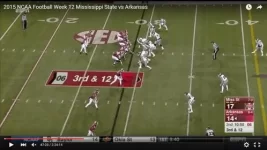
This screen shot shows where the value of communication in the LB’s/DB’s will come into play.

It’s an automatic blitz if there is no receiver threatening the boundary, and they send the DB up top. If you’re wondering why he isn’t blitzing in a straight line; that’s why. He needs to make sure no receiver threatens his zone first and then loops inside the edge rusher who attacks the outside shoulder of the LT. The nickel is trying to get out to his zone, in my mind he’s taking too flat of an angle here. I think he’s going so flat to get out and attack any underneath pass because the slot WR you see will be carrying that S up the seam. He doesn’t backpedal because the MLB has the slant behind him and the cloud zone on the hash. The off corner has the responsibility of staying deeper than the sticks on this one. He’s fine with a comeback or out route, as he will then come up and make the tackle short of the first down.
In this case, the defense does exactly what it’s intended to do as far as coverage goes, as the LB gets back to the sticks, the FS covers for the blitzing boundary corner and deeper than the deepest, forcing the QB to throw the ball high to find a soft spot in the zone. He’s not really open despite the way this screen shot looks. If he throws it lower, it’s right to the LB.
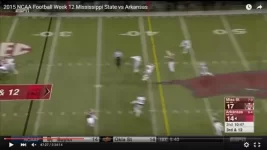
Going back to the rush on this play, I’d still rather see the rusher rush to the outside of the outside rusher so the edge defender can force a double team and possibly stop the blocker from picking him up. This is a pristine pocket with five rushers.
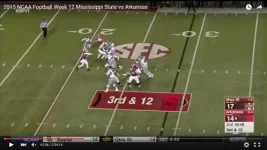
Here is an example of how they look to disguise their blitzes.
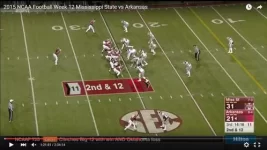
The QB sees a MLB A-gap blitzer, or at the very least he sees single-high safety with cloud zone behind it. If it’s me, I’m seeing one-on-one coverage on the outside with no S help, but that’s not what actually happened:
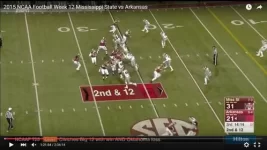
Instead, the MLB drops into the middle to take away the slant from the slot WR, the WLB blitzes the B gap, the CB plays press-bail, and the rusher has to only get past the RB to hit the QB (he doesn’t do so, but players play, the coaches can only put players in position to make plays). FWIW, the QB did end up throwing the ball deep to the split end WR and he was open, the ball was just overthrown.
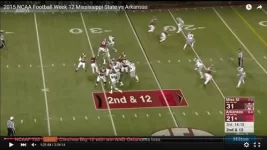
It will be fun to get back to being a one-gap team where our DL try to penetrate off the snap and make plays in the backfield:

I’ve reviewed every play of defense in this game, and you look at the stats and you see Arkansas just piling up the stats and think there’s terrible defense, but really, you have to give some credit to Arkansas. MSU simply cannot get to Brandon Allen. They have not sacked Allen despite continuously sending multiple blitzers at him. They have zero sacks to this point in the game and have turned the ball over twice in-a-row after giving up a TD right before halftime. This play goes for a TD:
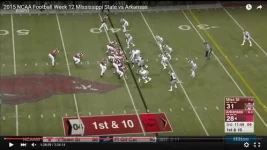
First play after another MSU turnover, the TE who probably goes 1st round had a S go for the cheese and takes a terrible angle. Runs all the way across the field, then turned it up the sideline and caught a beautiful throw.
Why is the S pushed all the way up here in this situation? My only answer is hero ball, because that is not his responsibility to be there.
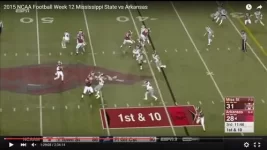
Tosses the ball with excellent anticipation as he’s getting crushed by a DT:
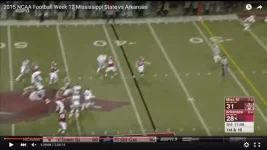
Then boom, perfect play, all setup by a S getting far out of his responsibility:
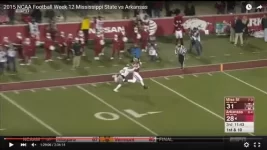
MSU turns the ball over immediately again, and you start to understand the numbers a little bit more after MSU held them in check most of the 1st half.
MSU could not handle Henry, who is a legitimate stud, but the S is just killing them out there. Why is he going inside on this play? He has help to the inside and the LB can’t cover the outside shoulder here. Why is the S not seeing this and getting to the flag route? If he simply sticks to the outside shoulder of the TE and then comes upfield, it’s an incompletion at worst, and an interception at best. That’d frustrate me as a coach.
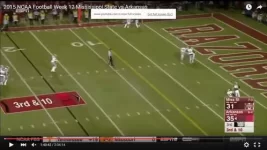
Three and out for the offense, again throwing the defense back out there. One gapping out there and staying after it. No pattycake ends in a loss of 2:
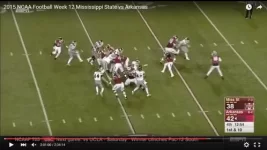
Every time I look up #7 is getting roasted. This guy killed them:

I’ve noticed this happen in a few games now. This defense tends to bite hard on play action. I’d like to see this improve.
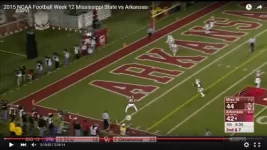
First play after taking lead late, you see them really push to make a play in the backfield. The DT is nearly taking the handoff himself:
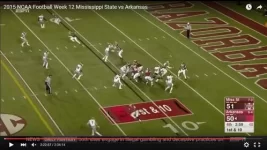
After reviewing all of these plays and tracking how he uses his defense I have some observations. Diaz loves to run cover-3 on the backend of the defense. The point being, of course, to limit the number of big plays they give up after being aggressive on the front-end. Cover 3 is a three-deep, four-under zone defense run out of both base and sub-package personnel. A scheme that shows up often in early down-and-distance situations to create an eight-man front, this defense allows for stopping the run and pressuring the QB. In the standard three-deep (rush four, drop seven), both cornerbacks drop to the outside third with the free safety playing the deep middle of the field (or middle third, hence the name "cover-3"). Underneath, the strong safety and weak-side linebacker (or nickel) play the curl-flat drops with two linebackers sinking to the middle hook drops inside. Here is a photo explaining it as well (this photo is not mine, it's from Game Rewind):

One thing I do want to point out that I think gets confused often is the difference between "press" and "press with jam" coverage on the edge. Press coverage does not really mean to hit the WR off the LOS, it is simply up on the WR to prevent the easy yards from the QB standing up and throwing it to WR when the CB is seven yards off him. A jam is when the CB actually physically hits the WR at the LOS. Diaz likes to run press coverage, but does not actually jam that often from what I saw. In fact, he is a big fan of press-bail coverage, which is when the CB comes up to the WR at the start, but when the ball is snapped the CB will "bail" away from the WR and start getting deep. This is another example of the defense looking to avoid big plays, as press bail allows the CB to get deep quicker, while still preventing the easy yards from the QB standing up and throwing the ball to the uncovered WR.
Note: In cover-3 the strong safety is a run defender and must be able to hit, tackle, and still run with the TE. The SS has to squeeze the runner back inside and maintain the edge by attacking any lead blocker with an inside shoulder technique (staying wider than any wide run).
This defense is vulnerable to the flats and slants from a 3-step drop when the defense one-gaps. Basically, if the DL doesn't get there, the QB has a lot of open space to deliver the ball to against either man or zone coverage. You see this show up both on film and in the numbers against the Diaz defense.
In a cover-3 against the slot WR, the nickel corner actually becomes a run defender, while the SS rolls over to the #2 WR to the open side of the formation (wide-side). As you can see, this is why the nickel corner and SS positions in a Diaz defense are so important. The FS is ultra-important as well because he will have to play single-high (cover-1), middle third (cover-3), and deep half in cover-2. We need good safeties to play this defense at an elite level. Luckily, south Florida tends to produce those.
Diaz also employs quite a bit of cover-2 coverage. The big difference with the cover-2 and the cover-3 is that the corners will actually jam the WR at the LOS and try to force them to an inside release, rather than allowing them outside and down the sideline. If you allow the WR down the sideline it creates even more space the S's have to get to on their halves of the field. The MLB'er tends to cover down the seam of the middle third of the field. This is generally called the "Tampa-2" look. Diaz runs a little different type of cover-2, but these are the basics. The big downside with this defense is that your corners are required to support the run and be physical. Generally, Richt wants bigger corners who will support the run and this defense is one of the reasons why. It's a safe defense in preventing big plays and stopping the run, but it tends to allow long drives on high number of plays if an offense executes and stays disciplined by not forcing the ball. I say this defense limits explosive plays, but a big exception to this is one of my favorite plays- four verticals. This is just what it sounds and requires the S to be in no-man's land and the LB's to carry the seam. This play is a staple of the Baylor passing offense.
One of my favorite defenses to run, and one that I don't see from Diaz much, is cover-6. This defense gets its name from the fact one side plays cover-3 and the other side plays cover-2. (3 x 2 = 6, hence the name cover-6). What this defense requires is one physical CB who can defend the run and then the other side is freed up to support the "lesser" corner on the other side. It also allows one side to cover up for a S who might be great versus the run, but struggle a little more versus the pass. Clemson ran quite a bit of cover-6 with Mackensie Alexander. Alexander's side ran the cover-2 and the other side ran the cover-3. The elite corner can bait the QB into throws that might result in picks and allows a defense to have an extra run defender, while hopefully shutting down the other side with cover-3.
Our personnel would fit the cover-6 if Redwine develops as hoped, where he can press-jam the WR and cover up some of the deficiencies of one of our safeties. Elder is a great cover-3 corner with his recovery speed.
The Diaz defense turned out to be better than I expected when all is said and done. I'd like to see him clean up some of the conversions allowed by playing softer coverage more often and not getting frustrated or antsy when the defense isn't getting to the QB early in the game. If we implement a little more cover-6 into the cover-3 tendencies and tailor our game plan to our opponent I am confident he can really turn this defense around quickly thanks to the simple-but-effective techniques he asks of his players. Cover-3 is a first day install at any high school program on defense so it isn't asking a lot of his players outside of SS and nickel CB, which has to play both as a force player (against the run) and carry a certain zone (seam for SS, underneath for nickel).
Welcome back to the days of Miami football. The days of pressuring QB's, forcing turnovers, and SS's who want to end your game.
• Southern Miss- I looked at this game as it was on the road against a little brother who wanted to beat them more than anything, and it was the first game
• Auburn- Complete spread team with a power run game and a coach I think has clever schemes.
• Arkansas- A traditional offense with an excellent college QB.
• NC State- Bowl game, more prep time, good offense.
I charted every play and came away with some observations:
• In 304 plays, they rushed 4 on 161 of those plays (53.0% of the time)
• They rushed 3 on only 17 plays, with 15 of those coming on 3rd and long (5.6%)
• They rushed 5 on 79 plays, but against Arkansas, the traditional offense of the opponent group, they rushed 5 on 26 plays, and rushed 4 on 27 plays (virtually identical). Against spread teams they almost exclusively rushed 4.
• Diaz sent 6 rushers on 47 plays, only 15.5% of the time. I excluded the goal line plays, where defenses rush 6 or 7 on almost every play and they skew the numbers because a successful play is going to net you 2-5 yards.
Diaz’ defense basically wants to pressure you at all costs with their front-7, then they try to protect dep. Think of the field like a big circle, where the circle extends 10 yards past the LOS, 10 yards from the sidelines, and then 10 yards in front of the Safeties. The hole in this defense is within that area where the circle outline ends (the “hole” in the circle if you will). I purposely tried to avoid too many metrics on his defense to see if what I evaluated showed up in the statistics, and sure enough, MSU was highly rated in the tackles for loss, fared well in preventing big plays, and was below average in getting 3 and outs, and ending drives quickly. If a QB has an elite TE and a good OL, they will shred this defense. One poster on here went a little overboard with his criticism of the pass defense, but this defense is easier to pass against than it is to run against.
When it comes to 3rd down defense, you will see they did a very good job with stopping teams on 3rd down, 24-69 for 34.8% on 3rd downs. What this doesn't tell you though is teams went 0-9 on 3rd down when they rushed 3 defenders and dropped 8 into coverage. There is some bias built in here due to the fact they rushed 3 on the 3rd and longs only, so you'd expect them to stop them more often. It's a positive they rarely gave up 3rd and longs when going conservative. On the flip side, when the defensive went ultra-aggressive and rushed 6, the offense converted 8 of 15 opportunities (53%). When rushing 5, the offense converted 9 of 21 opportunities (43%), and when rushing 4 the opponent converted 7 of 24 chances (29%).
What this information doesn't tell you though is how often the opponent got the first down before needing to reach 3rd down. They had 101 2nd downs and only 69 third downs, meaning the offense converted a 1st down prior to 3rd down on 32% of their opportunities (a relatively high number).
Most of the big plays I saw the defense give up were the result of play action and a defensive back peeking into the backfield, or a trick play where the defense overpursued. That is something we will need to get used to- there will be plays where the defense gives up a big play out of overaggression. Some of the other big plays I noticed were simply the coach put them in position, but a player tried to do too much and allowed the offense to make a play.
I really liked the fact that Diaz aligns his words with his actions. He does, in fact, allow his players to play fast. What I believe will happen as we go along, is the speed of his defensive players here will close that circle I spoke of earlier from 10 yards from the LOS to 12 yards, and the end of the circle will change from 10 yards in front of the S to 12 yards in front. This sounds like a small difference, but think of the difference two yards makes in coverage ability. You’ve effectively shrunk the middle of the circle from a 40 yard area (10 x 4 zones) down to a 24 yard area to attack (6 x 4 zones). That’s a massive difference and would take a defense from really good to elite. Most college QB’s simply won’t be able to attack this area.
Weaknesses I found are that if the front-7 doesn’t get to the QB he will have a field day. They sacked Brandon Allen zero times in the Arkansas game and he shredded them. QB’s who can run and move around will really hurt this defense. In the NC State game, the QB did by far the most damage against them by running the ball or moving and passing the ball downfield. Elite TE’s will shred this defense in the middle of the field if the QB can get him the ball.
This defense will get back to hitting the opponent again and I am excited about that. The defense hit the QB on 30% of their dropbacks in these four games (44 out of 148 dropbacks).
Here are some observations with some screen shots from the four games, with the most focus on the Arkansas game as it intrigued me the most.
In this play against Southern Miss, the offense ran a jet sweep motion, the QB leaked to the other side of the field and the WR lateraled to the QB. The QB threw deep and here is how the defense was in position to stop this play.

The CB stops his feet because you see that all the time when the ball is in the air that long. Keep running young fella! Instead, he stop running, squares up and tries to jump to intercept the ball. The S is caught watching the man instead of playing the ball.

The result, as I'm sure you guessed, is that the ball is completed down to the 4-yard line. Maybe I'm being too easy on them, but this huge 50-yard play is something I kind of pass to because the coach put them in position, but the players just didn't make the easy play.

This is another play against Southern Miss that annoyed me. A simple draw play, the defense is in great position to stop it for a simple four yard gain, but they allow a huge play instead.

In the screen shot above, you have an unblocked slot corner not paying attention to the runner, an ILB scraping down the line to meet him in the hole, and a boundary corner at the second level trailing the WR if he does somehow get past those two. Here's the next frame:

The ILB misses the tackle, the nickle CB slips to the ground, the boundary CB isn't looking at the ball and then even sets a beautiful screen preventing his S from getting over to tackle the ballcarrier. He ends up running for 44 yards down the sideline. Now, you decide for yourself if this is the defense getting shredded, or the defense being in a position to make the plays and a bunch of guys simply failing to make the easy play and stop this play.
There is another play with 10 guys within 10 yards of the LOS. I don't think I saw more than a handful of plays under our previous regime with more than 8 guys within 10 yards of the LOS. This makes me smile.
Switching to the Arkansas game, Diaz likes the two down linemen setup and walks up blitzers from all angles:

He does this so the defense isn’t sure where the blitzers are coming from. In virtually all long yardage situations they had two or three down linemen.

This screen shot shows where the value of communication in the LB’s/DB’s will come into play.

It’s an automatic blitz if there is no receiver threatening the boundary, and they send the DB up top. If you’re wondering why he isn’t blitzing in a straight line; that’s why. He needs to make sure no receiver threatens his zone first and then loops inside the edge rusher who attacks the outside shoulder of the LT. The nickel is trying to get out to his zone, in my mind he’s taking too flat of an angle here. I think he’s going so flat to get out and attack any underneath pass because the slot WR you see will be carrying that S up the seam. He doesn’t backpedal because the MLB has the slant behind him and the cloud zone on the hash. The off corner has the responsibility of staying deeper than the sticks on this one. He’s fine with a comeback or out route, as he will then come up and make the tackle short of the first down.
In this case, the defense does exactly what it’s intended to do as far as coverage goes, as the LB gets back to the sticks, the FS covers for the blitzing boundary corner and deeper than the deepest, forcing the QB to throw the ball high to find a soft spot in the zone. He’s not really open despite the way this screen shot looks. If he throws it lower, it’s right to the LB.

Going back to the rush on this play, I’d still rather see the rusher rush to the outside of the outside rusher so the edge defender can force a double team and possibly stop the blocker from picking him up. This is a pristine pocket with five rushers.

Here is an example of how they look to disguise their blitzes.

The QB sees a MLB A-gap blitzer, or at the very least he sees single-high safety with cloud zone behind it. If it’s me, I’m seeing one-on-one coverage on the outside with no S help, but that’s not what actually happened:

Instead, the MLB drops into the middle to take away the slant from the slot WR, the WLB blitzes the B gap, the CB plays press-bail, and the rusher has to only get past the RB to hit the QB (he doesn’t do so, but players play, the coaches can only put players in position to make plays). FWIW, the QB did end up throwing the ball deep to the split end WR and he was open, the ball was just overthrown.

It will be fun to get back to being a one-gap team where our DL try to penetrate off the snap and make plays in the backfield:

I’ve reviewed every play of defense in this game, and you look at the stats and you see Arkansas just piling up the stats and think there’s terrible defense, but really, you have to give some credit to Arkansas. MSU simply cannot get to Brandon Allen. They have not sacked Allen despite continuously sending multiple blitzers at him. They have zero sacks to this point in the game and have turned the ball over twice in-a-row after giving up a TD right before halftime. This play goes for a TD:

First play after another MSU turnover, the TE who probably goes 1st round had a S go for the cheese and takes a terrible angle. Runs all the way across the field, then turned it up the sideline and caught a beautiful throw.
Why is the S pushed all the way up here in this situation? My only answer is hero ball, because that is not his responsibility to be there.

Tosses the ball with excellent anticipation as he’s getting crushed by a DT:

Then boom, perfect play, all setup by a S getting far out of his responsibility:

MSU turns the ball over immediately again, and you start to understand the numbers a little bit more after MSU held them in check most of the 1st half.
MSU could not handle Henry, who is a legitimate stud, but the S is just killing them out there. Why is he going inside on this play? He has help to the inside and the LB can’t cover the outside shoulder here. Why is the S not seeing this and getting to the flag route? If he simply sticks to the outside shoulder of the TE and then comes upfield, it’s an incompletion at worst, and an interception at best. That’d frustrate me as a coach.

Three and out for the offense, again throwing the defense back out there. One gapping out there and staying after it. No pattycake ends in a loss of 2:

Every time I look up #7 is getting roasted. This guy killed them:

I’ve noticed this happen in a few games now. This defense tends to bite hard on play action. I’d like to see this improve.

First play after taking lead late, you see them really push to make a play in the backfield. The DT is nearly taking the handoff himself:

After reviewing all of these plays and tracking how he uses his defense I have some observations. Diaz loves to run cover-3 on the backend of the defense. The point being, of course, to limit the number of big plays they give up after being aggressive on the front-end. Cover 3 is a three-deep, four-under zone defense run out of both base and sub-package personnel. A scheme that shows up often in early down-and-distance situations to create an eight-man front, this defense allows for stopping the run and pressuring the QB. In the standard three-deep (rush four, drop seven), both cornerbacks drop to the outside third with the free safety playing the deep middle of the field (or middle third, hence the name "cover-3"). Underneath, the strong safety and weak-side linebacker (or nickel) play the curl-flat drops with two linebackers sinking to the middle hook drops inside. Here is a photo explaining it as well (this photo is not mine, it's from Game Rewind):

One thing I do want to point out that I think gets confused often is the difference between "press" and "press with jam" coverage on the edge. Press coverage does not really mean to hit the WR off the LOS, it is simply up on the WR to prevent the easy yards from the QB standing up and throwing it to WR when the CB is seven yards off him. A jam is when the CB actually physically hits the WR at the LOS. Diaz likes to run press coverage, but does not actually jam that often from what I saw. In fact, he is a big fan of press-bail coverage, which is when the CB comes up to the WR at the start, but when the ball is snapped the CB will "bail" away from the WR and start getting deep. This is another example of the defense looking to avoid big plays, as press bail allows the CB to get deep quicker, while still preventing the easy yards from the QB standing up and throwing the ball to the uncovered WR.
Note: In cover-3 the strong safety is a run defender and must be able to hit, tackle, and still run with the TE. The SS has to squeeze the runner back inside and maintain the edge by attacking any lead blocker with an inside shoulder technique (staying wider than any wide run).
This defense is vulnerable to the flats and slants from a 3-step drop when the defense one-gaps. Basically, if the DL doesn't get there, the QB has a lot of open space to deliver the ball to against either man or zone coverage. You see this show up both on film and in the numbers against the Diaz defense.
In a cover-3 against the slot WR, the nickel corner actually becomes a run defender, while the SS rolls over to the #2 WR to the open side of the formation (wide-side). As you can see, this is why the nickel corner and SS positions in a Diaz defense are so important. The FS is ultra-important as well because he will have to play single-high (cover-1), middle third (cover-3), and deep half in cover-2. We need good safeties to play this defense at an elite level. Luckily, south Florida tends to produce those.
Diaz also employs quite a bit of cover-2 coverage. The big difference with the cover-2 and the cover-3 is that the corners will actually jam the WR at the LOS and try to force them to an inside release, rather than allowing them outside and down the sideline. If you allow the WR down the sideline it creates even more space the S's have to get to on their halves of the field. The MLB'er tends to cover down the seam of the middle third of the field. This is generally called the "Tampa-2" look. Diaz runs a little different type of cover-2, but these are the basics. The big downside with this defense is that your corners are required to support the run and be physical. Generally, Richt wants bigger corners who will support the run and this defense is one of the reasons why. It's a safe defense in preventing big plays and stopping the run, but it tends to allow long drives on high number of plays if an offense executes and stays disciplined by not forcing the ball. I say this defense limits explosive plays, but a big exception to this is one of my favorite plays- four verticals. This is just what it sounds and requires the S to be in no-man's land and the LB's to carry the seam. This play is a staple of the Baylor passing offense.
One of my favorite defenses to run, and one that I don't see from Diaz much, is cover-6. This defense gets its name from the fact one side plays cover-3 and the other side plays cover-2. (3 x 2 = 6, hence the name cover-6). What this defense requires is one physical CB who can defend the run and then the other side is freed up to support the "lesser" corner on the other side. It also allows one side to cover up for a S who might be great versus the run, but struggle a little more versus the pass. Clemson ran quite a bit of cover-6 with Mackensie Alexander. Alexander's side ran the cover-2 and the other side ran the cover-3. The elite corner can bait the QB into throws that might result in picks and allows a defense to have an extra run defender, while hopefully shutting down the other side with cover-3.
Our personnel would fit the cover-6 if Redwine develops as hoped, where he can press-jam the WR and cover up some of the deficiencies of one of our safeties. Elder is a great cover-3 corner with his recovery speed.
The Diaz defense turned out to be better than I expected when all is said and done. I'd like to see him clean up some of the conversions allowed by playing softer coverage more often and not getting frustrated or antsy when the defense isn't getting to the QB early in the game. If we implement a little more cover-6 into the cover-3 tendencies and tailor our game plan to our opponent I am confident he can really turn this defense around quickly thanks to the simple-but-effective techniques he asks of his players. Cover-3 is a first day install at any high school program on defense so it isn't asking a lot of his players outside of SS and nickel CB, which has to play both as a force player (against the run) and carry a certain zone (seam for SS, underneath for nickel).
Welcome back to the days of Miami football. The days of pressuring QB's, forcing turnovers, and SS's who want to end your game.
